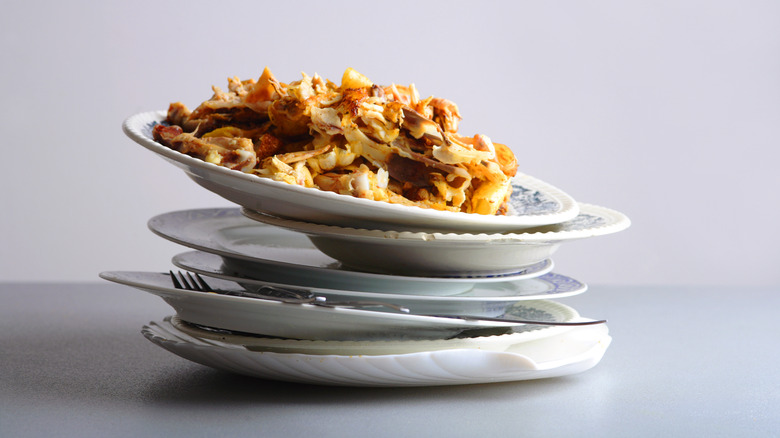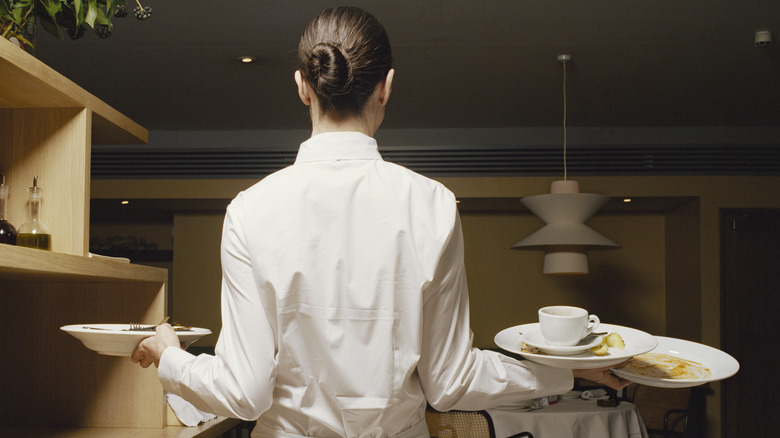Why You Should Think Twice Before Stacking Empty Plates At A Restaurant
It might be the most hotly-debated question among servers: Is it okay for customers to stack their plates once they're done eating? Multiple viral TikToks have addressed this question, but unfortunately, there isn't a single, clear-cut answer. However, there are right and wrong places to stack your plates, and right and wrong ways to do it, if you must.
Before you stack your plates, keep in mind that it can cause extra work for the restaurant staff. While it's usually done by customers who mean well and just want to help the server, plates can often be piled up unevenly, causing more problems than if the server had just cleared the table normally, such as the risk of dropping dishware. Similarly, leftovers can get mashed up in the stack, making the pre-stacked plates gross and awkward to handle.
At the same time, it's certainly possible to find servers who do appreciate it. For example, if a server has to awkwardly lean over customers to grab empty plates, maybe that's a situation where it would be more appropriate. Plus, a flustered, overworked server may simply appreciate the plates being stacked if it saves them a few seconds (although it would be wrong to assume all servers prefer this).
Stacking your plates can cause more work for your server
When it comes to the question of restaurant etiquette, it seems that experts generally lean in one direction: You shouldn't stack your plates at a restaurant. The reasons for this are manifold. Beyond the fact that most servers have their own system for clearing tables, it can even slow them down if they have to re-stack all the plates because the job was done poorly. It can make the restaurant look bad (as if servers aren't doing their job) — it can even make servers feel a little disrespected, as if customers are doing the job for them. Stacking the plates may even reflect poorly on diners, suggesting they don't know how to eat out.
Although "don't stack" is the general rule, there are settings where it may be more acceptable. Most obviously, you should do it in a fast-casual restaurant where customers are expected to bus their own tables. The higher-end the restaurant, the more of a no-no it is. Correspondingly, if you're at a very casual table-service place (for example, a diner), it's a little more acceptable. Also, in the event that the table is totally full and more plates are arriving (for example, at a small plates or dim sum restaurant), stacking the empties may be inevitable — although, of course, a server should ideally have removed those excess plates.
The rules, if you must stack your plates
If you decide to stack your plates, there are a few guidelines to follow. Firstly, don't do it until everybody has finished eating. It's considered rude for servers to clear a table while people are still dining, so by stacking some plates, you're forcing them to break this rule, or else they might look incompetent for ignoring a pile of empty dishes.
Next, stack the plates as evenly as you possibly can so that the pile doesn't wobble. This means placing the biggest plates at the base (if there are differently-sized plates on the table) and scraping off any leftovers onto one plate that can go either on top of the stack or off to the side. Make sure that the leftovers plate isn't overfull so the server won't stick their hand into your half-eaten food, or spill it on the way to the kitchen.
Where to place the silverware is tricky. You can put it on the top plate in the stack as long as there's not too much and it's unlikely to fall off. But if things are looking unstable, you may want to put the knives and forks in a glass or cup on the side. Leave the napkins off the plates entirely, especially if they're cloth (as opposed to paper), and make sure the stack is somewhere the server can easily reach. But ultimately, if you can avoid stacking at all, that may just be the better choice.


